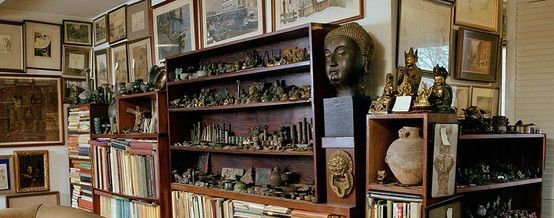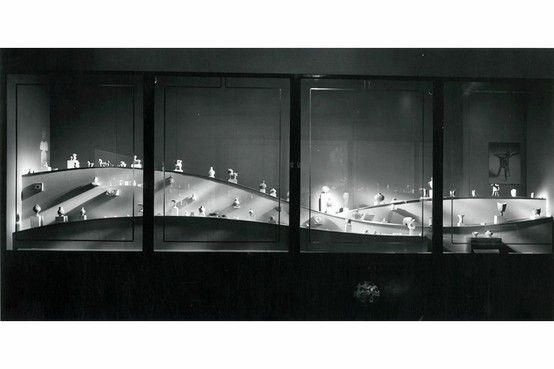Exhibition of Paul Singer Collection marks new beginnings for research in ancient Chinese art
Miniature cockscomb ewer, China, Liao dynasty, 11th century. Earthenware with white slip under copper-green, lead glaze. H x W x D: 7.1 x 3.9 x 3.5 cm. Arthur M. Sackler Gallery RLS1997.48.185.
WASHINGTON, DC.- Renowned for his passionate dedication to ancient Chinese material culture, collector Dr. Paul Singer (1904–1997) built an expansive collection of some 5000 objects, once displayed in its entirety in his modest two-bedroom apartment in New Jersey. The selection of 63 works in “One Man’s Search for Ancient China: The Paul Singer Collection,” on view Jan. 19–July 7 at the Arthur M. Sackler Gallery, provides a glimpse into Singer’s seven decades of work in ancient Chinese art.
Singer’s collection, most of which has never been on public view, reflects an enormous range of artifacts produced by ancient Chinese cultures. Although it includes masterworks appreciated for their beauty, its greatest value resides in the large number of minor pieces—from objects of personal adornment to ceramics and weaponry— that form an almost encyclopedic reference for archaeological study.
“The Singer collection fills in many gaps in the story of early China,” said J. Keith Wilson, exhibition curator and curator of ancient Chinese art at the Freer and Sackler galleries. “Objects such as these are found in few museum collections, but they contribute greatly to our understanding and study of thousands of years of history.”
A psychiatrist by profession, Singer was a self-taught collector who focused on ancient artifacts at a time when Chinese archaeology was a rapidly expanding field. He also delighted in “mystery objects” of unknown origin or use that presented him with archaeological puzzles. Some of these enigmatic objects are on view in the exhibition.
“One Man’s Search for Ancient China” displays Singer’s particular interests, including pre-Anyang bronzes, decorative gold fragments and jewelry, and objects associated with the ancient culture of Chu, located in south China. It also features some of his more unorthodox curiosities, such as a sword, fittings and box all purportedly unearthed together, and a lacquer cosmetic box that still holds a woman’s ancient hairpieces. Almost all of the objects are small in scale, especially the numerous miniature vessels and figurines that earned Singer the nickname “Mr. Miniature.”
The collection’s wealth of media reflects Singer’s ambition to “present a sequential development in all the materials worked by Chinese artists.” Unfazed by the large quantity of artworks, he meticulously categorized them and assigned each item its place in his apartment. He frequently opened his home to fellow enthusiasts, and as an active scholar, he pioneered research and understanding of the Chu state (6th–3rd c. BCE), becoming one of the first Westerners to collect and publish on the topic.
Dr. Arthur M. Sackler, a friend of Singer and founder of the Sackler Gallery, appreciated Singer’s collecting and research interests and financially supported them beginning in the 1970s, with the understanding that all acquisitions would eventually be donated to a Sackler museum. Enriching the Sackler Gallery’s permanent collection, Singer’s gift also creates future opportunities for active research, for exhibitions with rich cultural context, and for collaboration with international institutions.
“One Man’s Search for Ancient China” is one of a number of exhibitions on view in 2013 that feature individual collectors whose contributions to the Freer and Sackler Galleries have revolutionized the understanding and appreciation of major areas of Asian art. Other exhibitions feature the vision of Freer Gallery’s founder Charles Lang Freer (“Promise of Paradise: Early Chinese Buddhist Sculpture,” on view indefinitely) and Gerhard Pulverer (“Hand-Held: Gerhard Pulverer’s Japanese Illustrated Books,” April 6-Aug. 11, 2013).
Plaque in the form of addorsed dragons, China, Eastern Zhou dynasty, Spring and Autumn period to early Warring States period, 6th–5th century BCE. Bronze with gold foil, H x W x D (overall): 13.1 x 9.5 x 0.1 cm. Arthur M. Sackler Gallery RLS1997.48.4508
Paul Singer's apartment in Summit, New Jersey, 1997. Photo by John Tsantes.
Objects in Early Chinese Miniatures, an exhibition Singer organized for China Institute in America, New York City, 1977
Paul Singer in his apartment in Summit, New Jersey, 1990s

/https%3A%2F%2Fprofilepics.canalblog.com%2Fprofilepics%2F1%2F0%2F100183.jpg)
/https%3A%2F%2Fstorage.canalblog.com%2F03%2F02%2F119589%2F96711876_o.jpg)
/https%3A%2F%2Fstorage.canalblog.com%2F11%2F31%2F119589%2F94773502_o.jpg)
/https%3A%2F%2Fstorage.canalblog.com%2F20%2F83%2F119589%2F94772815_o.jpg)
/https%3A%2F%2Fstorage.canalblog.com%2F26%2F72%2F119589%2F75604929_o.jpg)
/https%3A%2F%2Fstorage.canalblog.com%2F59%2F60%2F119589%2F26458628_o.jpg)







/image%2F1371349%2F20240406%2Fob_b23648_434058570-1644317966338216-88086167391.jpg)
/http%3A%2F%2Fstorage.canalblog.com%2F93%2F82%2F119589%2F128656009_o.jpg)
/http%3A%2F%2Fstorage.canalblog.com%2F07%2F62%2F119589%2F127708440_o.png)
/http%3A%2F%2Fstorage.canalblog.com%2F61%2F00%2F119589%2F127154963_o.jpg)